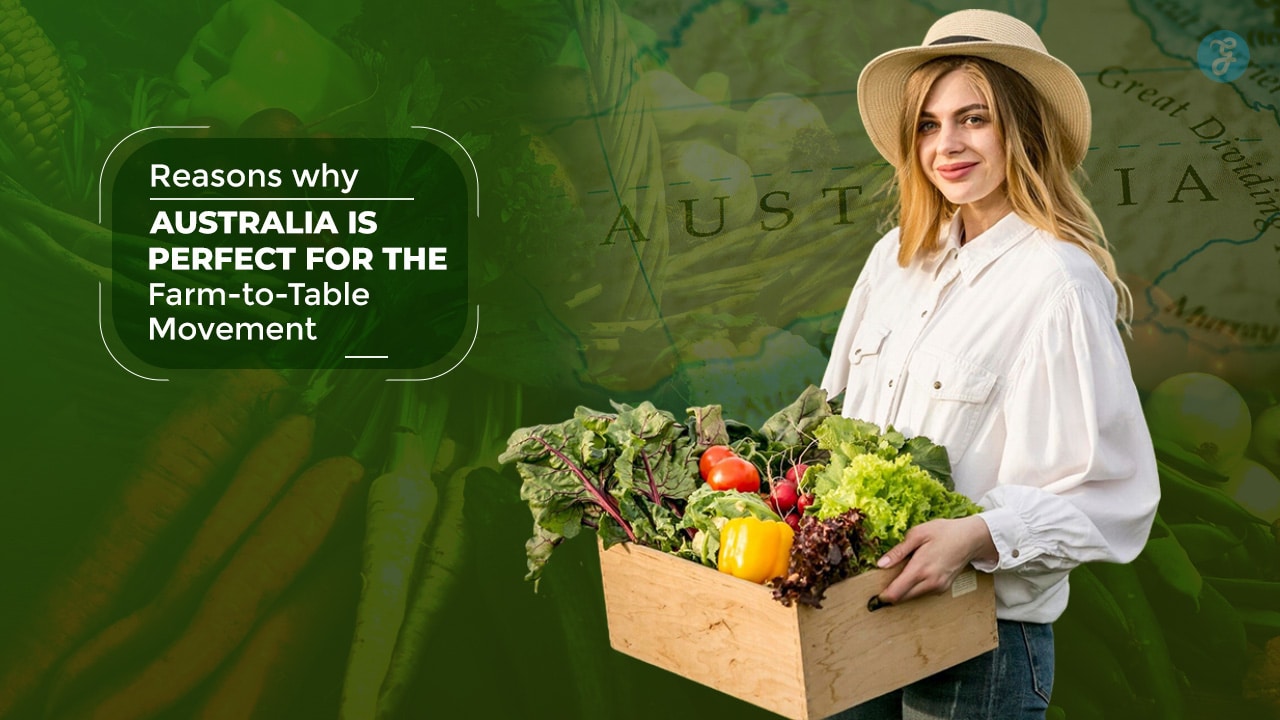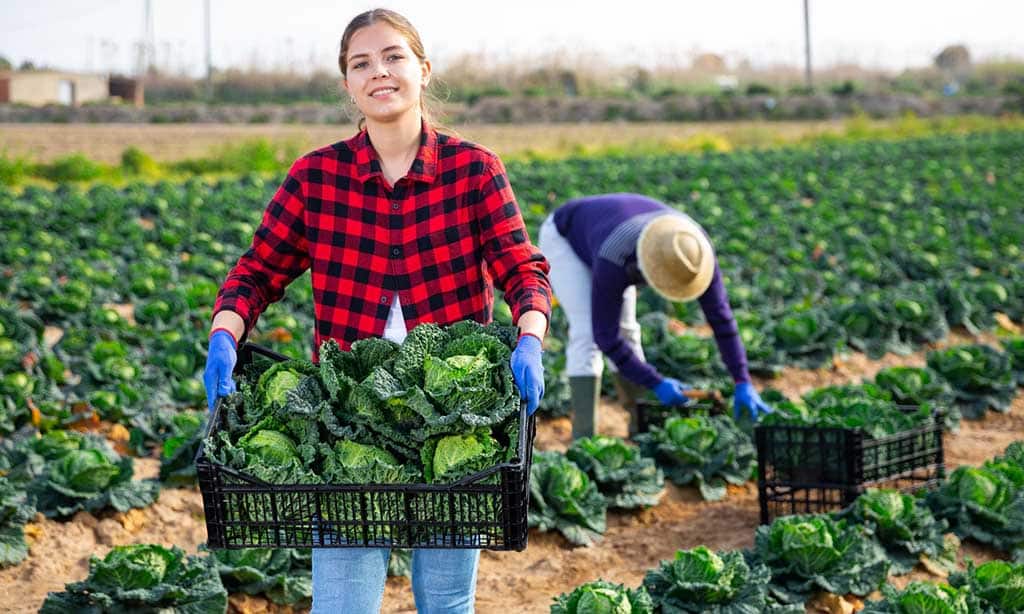Australia has emerged as a global leader in the farm-to-table movement, a philosophy centered around sourcing food locally to promote sustainability, health, and economic growth. With its rich agricultural heritage, diverse climate, and passionate food culture, Australia provides the perfect conditions for this thriving movement.
Whether you’re a foodie, a farmer, or simply someone interested in sustainable living, the reasons behind Australia’s dominance in farm-to-table practices are compelling.
Let’s explore the 20 key factors that make Australia a standout destination for farm-to-table enthusiasts.
The Farm-to-Table Movement: A Quick Overview
Let’s take a look.
What Is the Farm-to-Table Movement?
The farm-to-table movement connects consumers directly with local producers. It prioritizes fresh, seasonal ingredients, eliminating the middleman and significantly reducing the time food travels from the farm to your plate. This movement not only supports local farmers but also encourages eco-friendly practices and healthier eating habits.
Actionable Tip: When dining out, look for menus that highlight local suppliers or specific farm partnerships. This ensures you’re supporting farm-to-table initiatives.
Why Is Farm-to-Table Important?
Farm-to-table practices promote sustainability by reducing carbon footprints, improving local economies, and providing fresher, nutrient-rich food. For Australia, a country with a strong agricultural base and a growing focus on environmental conservation, the farm-to-table movement aligns perfectly with national values and goals.
Real-Life Insight: Many Australian cities, including Melbourne and Sydney, now host regular farm-to-table festivals showcasing local produce and chefs.
Why Australia Leads in the Farm-to-Table Movement?
1. Abundant Agricultural Resources
Australia’s vast expanses of farmland and favorable soil conditions make it ideal for growing a wide range of crops. States like Queensland and Victoria are known for their abundant harvests of fruits, vegetables, and grains.
This agricultural wealth lays a solid foundation for the farm-to-table movement.
| Region | Key Crops/Products |
| Queensland | Bananas, Mangoes, Pineapples |
| Victoria | Pears, Peaches, Tomatoes |
| New South Wales | Apples, Stone fruits, Dairy |
| Western Australia | Wheat, Barley, Chickpeas |
Example: Victoria’s Goulburn Valley, often referred to as Australia’s “food bowl,” supplies a significant portion of the nation’s fresh produce, including pears and peaches.
2. Sustainable Farming Practices
Australian farmers are pioneers in regenerative and organic farming techniques. These methods prioritize soil health, water conservation, and biodiversity, ensuring long-term sustainability.
Organizations like Australian Organic play a crucial role in certifying and promoting eco-friendly practices.
| Practice | Key Benefits |
| Regenerative Farming | Enhances soil health, reduces carbon footprint |
| Organic Farming | Prevents chemical use, promotes biodiversity |
Actionable Tip: When shopping, look for products with the “Australian Certified Organic” label to ensure you’re supporting sustainable agriculture.
3. Diverse Crop Production
Thanks to its varied climates, Australia produces everything from tropical fruits in Queensland to cool-climate grapes in Tasmania.
This diversity ensures a year-round supply of fresh, seasonal ingredients.
Table: Popular Farm-to-Table Crops by Region
| Region | Notable Crops |
| Queensland | Bananas, Mangoes, Pineapples |
| Tasmania | Apples, Potatoes, Dairy |
| South Australia | Grapes, Olives, Almonds |
| Western Australia | Wheat, Barley, Chickpeas |
4. Strong Support for Local Farmers
Government initiatives and community organizations in Australia actively support local farmers through grants, subsidies, and promotional programs.
Farmers’ markets are widespread, providing a platform for direct interaction between producers and consumers.
| Initiative | Description |
| “Buy From the Bush” | Connects rural farmers to urban consumers |
| Farmers’ Markets | Provides direct consumer access to local products |
Example: The “Buy From the Bush” campaign has helped rural farmers and artisans connect with urban consumers, boosting local economies.
5. World-Class Culinary Scene
Australia’s chefs and restaurateurs are champions of the farm-to-table philosophy. Renowned establishments like Brae in Victoria and Three Blue Ducks in New South Wales showcase menus crafted entirely from local ingredients, offering unparalleled dining experiences.
| Restaurant | Notable Characteristics |
| Brae (Victoria) | Seasonal menus, locally sourced ingredients |
| Three Blue Ducks | Commitment to sustainable, farm-to-table dining |
Pro Tip: Visit smaller regional towns like Daylesford, known for its farm-to-table restaurants that collaborate directly with nearby farms.
Geographic and Climatic Advantages
6. Regional Diversity
From tropical rainforests in the north to temperate zones in the south, Australia’s geographic variety contributes to a rich palette of produce.
This diversity ensures that restaurants and homes alike can access fresh, high-quality ingredients.
| Region | Geographic Feature | Crops Produced |
| Northern Australia | Tropical Climates | Mangoes, Sugar Cane |
| Southern Australia | Temperate Zones | Apples, Grapes, Wheat |
7. Year-Round Growing Seasons
Australia’s southern hemisphere location allows it to produce food during the northern hemisphere’s winter months.
This advantage not only supports local markets but also boosts exports of fresh produce worldwide.
Seasonal Availability of Key Australian Produce
| Season | Available Produce |
| Summer | Mangoes, Cherries, Zucchini |
| Autumn | Apples, Pumpkins, Grapes |
| Winter | Oranges, Broccoli, Cauliflower |
| Spring | Strawberries, Asparagus, Peas |
8. Clean Water Sources
Australia’s investment in water conservation and irrigation systems ensures a steady supply of clean water for farming.
The Murray-Darling Basin, for instance, supports nearly 40% of the country’s agriculture.
| Region | Key Water Source | Benefits |
| Murray-Darling Basin | Major river system | Supplies 40% of agricultural water |
Fact: Efficient irrigation systems in regions like Riverina have reduced water waste by over 20% in the last decade.
9. Wide Open Spaces for Livestock
Australia’s expansive grasslands are ideal for free-range farming. Livestock such as cattle and sheep benefit from natural grazing, producing high-quality, ethically raised meat and dairy products.
| Region | Livestock Type | Notable Product |
| Northern Territory | Cattle, Sheep | Free-range beef, lamb |
| Western Australia | Cattle, Sheep | Grass-fed beef, organic lamb |
Example: Free-range beef from the Northern Territory is highly sought after for its superior flavor and texture.
10. Access to the Ocean for Seafood
With over 25,000 kilometers of coastline, Australia’s farm-to-table movement seamlessly incorporates the concept of farm-to-sea.
Fresh seafood, including barramundi, oysters, and prawns, is a staple in coastal areas.
| Region | Notable Seafood Products |
| Queensland | Barramundi, Prawns, Oysters |
| Tasmania | Atlantic Salmon, Mussels |
| New South Wales | Prawns, Sydney Rock Oysters |
Pro Tip: Explore Sydney Fish Market for a firsthand look at the fresh seafood integrated into farm-to-table dining.
Cultural and Economic Factors Supporting Farm-to-Table
11. Australia’s Food Culture
Australians have a strong appreciation for fresh, locally sourced food. This cultural preference drives demand for farm-to-table dining, encouraging farmers and chefs to work together.
| Practice | Impact |
| Seasonal Menus | Restaurants change menus to reflect available, local produce |
| Local Food Trends | Growing demand for organic and regenerative produce |
Example: The “Paddock to Plate” tours offered in regions like Margaret River allow visitors to experience local farming firsthand.
12. Thriving Farmers’ Markets
Farmers’ markets are integral to Australia’s farm-to-table movement. They offer a platform for farmers to sell directly to consumers, fostering community connections and ensuring produce stays fresh.
| Market | Location | Key Features |
| Eumundi Markets | Queensland | Local produce, arts, crafts |
| South Melbourne Market | Victoria | Organic produce, direct farm access |
| Bondi Farmers Market | New South Wales | Local fresh food, organic options |
| Adelaide Farmers Market | South Australia | Local produce, sustainable farming |
| Fremantle Markets | Western Australia | Fresh produce, local artisans |
13. Tourism and Agritourism Growth
Farm-to-table dining has become a significant attraction for tourists. Visitors flock to Australia’s wine regions, organic farms, and eco-friendly resorts to experience the best of local cuisine.
| Region | Agritourism Experience | Focus |
| Barossa Valley | Vineyard tours and local dining | Wine and local food pairing experiences |
| Margaret River | Paddock to Plate tours | Experience fresh, local farm products |
Actionable Tip: Plan a visit to Barossa Valley for vineyard tours combined with locally sourced dining experiences.
14. Supportive Policies and Incentives
The Australian government supports farm-to-table initiatives through subsidies for organic farming, grants for sustainability projects, and funding for local food programs.
| Program | Focus | Impact |
| Organic Farming Subsidies | Financial aid for organic farming | Increases organic produce production |
| Sustainability Grants | Supports eco-friendly farming methods | Encourages long-term sustainability |
15. Export Opportunities and Global Recognition
Australia’s reputation for premium-quality organic produce is growing. Countries across Asia and Europe import Australian fruits, vegetables, and meats, further validating the nation’s leadership in sustainable farming.
| Product | Key Export Market | Recognition |
| Avocados | Japan | Recognized for quality and taste |
| Wine | Europe | Known for premium wine production |
Example: Australian avocados are now a key export to Japan, celebrated for their quality.
Health and Sustainability Benefits of Australia’s Farm-to-Table Practices
16. Focus on Organic Farming
Australia boasts over 35 million hectares of certified organic farmland—the largest in the world.
This focus on organic produce enhances food quality while protecting the environment.
| Region | Area of Organic Farming (Hectares) | Key Products |
| New South Wales | 7.5 million hectares | Vegetables, Grapes, Livestock |
| Victoria | 3.5 million hectares | Dairy, Fruit, Grains |
17. Reduced Carbon Footprint
By sourcing food locally, the farm-to-table movement significantly reduces transportation emissions. This practice is particularly vital in combating climate change.
| Factor | Benefit |
| Local Sourcing | Reduces transportation emissions |
| Sustainable Farming | Minimizes land use, water consumption, and carbon output |
18. Healthier Eating for Australians
Farm-to-table dining encourages the consumption of fresh, unprocessed foods. This shift reduces the risk of diet-related illnesses like obesity and diabetes.
| Benefit | Impact |
| Fresh Ingredients | Nutrient-rich, supports better health |
| Local Sourcing | Reduces processed food consumption |
19. Resilience to Global Supply Chain Disruptions
The COVID-19 pandemic underscored the importance of local food systems. Australia’s emphasis on self-reliant farming makes it less vulnerable to global supply chain issues.
| Event | Impact |
| COVID-19 Pandemic | Increased reliance on local food production |
Actionable Tip: Support local food delivery services that prioritize farm-to-table suppliers.
20. Promoting Biodiversity
Farm-to-table farming often involves crop rotation and polyculture, practices that protect biodiversity and improve soil health.
This ensures long-term sustainability.
| Practice | Environmental Benefit |
| Crop Rotation | Reduces soil depletion, increases biodiversity |
| Native Plant Integration | Enhances ecological balance |
Example: Many Australian farms are integrating native plants into crop rotations to promote ecological balance.
Takeaways
Australia’s rich agricultural heritage, diverse geography, and commitment to sustainability make it the ideal leader in the farm-to-table movement.
By embracing local food systems, Australians are fostering healthier lifestyles, supporting local economies, and safeguarding the environment for future generations.
Whether you’re savoring a meal at a farm-to-table restaurant or exploring a bustling farmers’ market, Australia’s dedication to fresh, local food is evident at every turn.








































